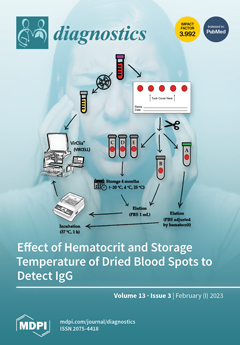Background: The usage of whole-slide images has recently been gaining a foothold in medical education, training, and diagnosis. Objectives: The first objective of the current study was to compare academic performance on virtual microscopy (VM) and light microscopy (LM) for learning pathology, anatomy,
[...] Read more.
Background: The usage of whole-slide images has recently been gaining a foothold in medical education, training, and diagnosis. Objectives: The first objective of the current study was to compare academic performance on virtual microscopy (VM) and light microscopy (LM) for learning pathology, anatomy, and histology in medical and dental students during the COVID-19 period. The second objective was to gather insight into various applications and usage of such technology for medical education. Materials and methods: Using the keywords “virtual microscopy” or “light microscopy” or “digital microscopy” and “medical” and “dental” students, databases (PubMed, Embase, Scopus, Cochrane, CINAHL, and Google Scholar) were searched. Hand searching and snowballing were also employed for article searching. After extracting the relevant data based on inclusion and execution criteria, the qualitative data were used for the systematic review and quantitative data were used for meta-analysis. The Newcastle Ottawa Scale (NOS) scale was used to assess the quality of the included studies. Additionally, we registered our systematic review protocol in the prospective register of systematic reviews (PROSPERO) with registration number CRD42020205583. Results: A total of 39 studies met the criteria to be included in the systematic review. Overall, results indicated a preference for this technology and better academic scores. Qualitative analyses reported improved academic scores, ease of use, and enhanced collaboration amongst students as the top advantages, whereas technical issues were a disadvantage. The performance comparison of virtual versus light microscopy meta-analysis included 19 studies. Most (10/39) studies were from medical universities in the USA. VM was mainly used for teaching pathology courses (25/39) at medical schools (30/39). Dental schools (10/39) have also reported using VM for teaching microscopy. The COVID-19 pandemic was responsible for the transition to VM use in 17/39 studies. The pooled effect size of 19 studies significantly demonstrated higher exam performance (SMD: 1.36 [95% CI: 0.75, 1.96],
p < 0.001) among the students who used VM for their learning. Students in the VM group demonstrated significantly higher exam performance than LM in pathology (SMD: 0.85 [95% CI: 0.26, 1.44],
p < 0.01) and histopathology (SMD: 1.25 [95% CI: 0.71, 1.78],
p < 0.001). For histology (SMD: 1.67 [95% CI: −0.05, 3.40],
p = 0.06), the result was insignificant. The overall analysis of 15 studies assessing exam performance showed significantly higher performance for both medical (SMD: 1.42 [95% CI: 0.59, 2.25],
p < 0.001) and dental students (SMD: 0.58 [95% CI: 0.58, 0.79],
p < 0.001). Conclusions: The results of qualitative and quantitative analyses show that VM technology and digitization of glass slides enhance the teaching and learning of microscopic aspects of disease. Additionally, the COVID-19 global health crisis has produced many challenges to overcome from a macroscopic to microscopic scale, for which modern virtual technology is the solution. Therefore, medical educators worldwide should incorporate newer teaching technologies in the curriculum for the success of the coming generation of health-care professionals.
Full article






